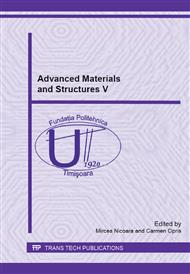[1]
C.N. Elias, Y. Oshidab, J. H. Cavalcanti Lima, C. A. Mullere, Relationship between surface properties (roughness, wettability and morphology) of titanium and dental implant removal torque, J Mech. Behr Biomed Mat, 1 (3) (2008) 234–242.
DOI: 10.1016/j.jmbbm.2007.12.002
Google Scholar
[2]
S.I. Voicu, A.C. Nechifor, B. Serban, G. Nechifor, M. Miculescu, Formylated Polysulphone Membranes for Cell Immobilization, J Optoelectron Adv M 9 (2007) 3423-3426.
Google Scholar
[3]
S. Bauer, P. Schmuki, K. von der Mark, J. Park, Progress in Materials Science, Engineering biocompatible implant surfaces: Part I: Materials and surfaces, 58 (3) (2013) 261–326.
DOI: 10.1016/j.pmatsci.2012.09.001
Google Scholar
[4]
O. Vasile, F. Miculescu, S.I. Voicu, Correlation aspects between morphology, infrared and acoustic absorptions properties of various material, Optoelectron Adv Mat 6 (5-6) (2012) 631-638.
Google Scholar
[5]
S.I. Voicu, A. Dobrica, S. Sava, A. Ivan, L. Naftanaila, Cationic surfactants-controlled geometry and domensions of polymeric membrane pores, J Optoelectron Adv M 14 (11-12) (2012) 923-928.
Google Scholar
[6]
J.E. Davies, E Ajami, R Moineddin, V.C. Mendesa, The roles of different scale ranges of surface implant topography on the stability of the bone/implant interface, Biomaterials, 34 (14) (2013) 3535–3546.
DOI: 10.1016/j.biomaterials.2013.01.024
Google Scholar
[7]
G. Nechifor, S.I. Voicu, A.C. Nechifor, S. Garea, Nanostructure hybrid membrane polysulfone-carbon nanotubes for hemodyalisis, Desalination 241 (2009) 342-348.
DOI: 10.1016/j.desal.2007.11.089
Google Scholar
[8]
D.M. Brunette, B. Chehroudi, The Effects Of The Surface Topography Of Micromachined Titanium Substrata On Cell Behavior In Vitro And In Vivo, J. Biom. Eng., 121 (1999) 49 –57.
DOI: 10.1115/1.2798042
Google Scholar
[9]
G. E. Stan, A. C. Popa, A. C. Galca, et al, Strong bonding between sputtered bioglass-ceramic films and Ti-substrate implants induced by atomic inter-diffusion post-deposition heat-treatments, Appl. Surf. Sci., 280 (2013) 530-538.
DOI: 10.1016/j.apsusc.2013.05.022
Google Scholar
[10]
G. Luo, A.M. Sadegh, H. Alexander, W. Jaffe, D. Scott, S.C. Cowin, The effect of surface roughness on the stress adaptation of trabecular architecture around a cylindrical implant, J Biomechanics, 32 (3) (1999) 275–284.
DOI: 10.1016/s0021-9290(98)00172-9
Google Scholar
[11]
G. E. Stan, I. Pasuk, M.A. Husanu, et al, Highly adherent bioactive glass thin films synthetized by magnetron sputtering at low temperature, J Mater Sci-Mater M 22 (12) (2012) 2693-2710.
DOI: 10.1007/s10856-011-4441-1
Google Scholar
[12]
G. Mendonçaa, D.B.S. Mendonçaa, F.J.L. Aragãoa, L.F. Cooper, Advancing dental implant surface technology – From micron- to nanotopography, Biomaterials, 29 (28) (2008) 3822–3835.
DOI: 10.1016/j.biomaterials.2008.05.012
Google Scholar
[13]
F Grizon, E Aguado, G Huré, M. F Baslé, D Chappard, Enhanced bone integration of implants with increased surface roughness: a long term study in the sheep, J Dentistry, 30 (5–6) (2002) 195–203.
DOI: 10.1016/s0300-5712(02)00018-0
Google Scholar
[14]
G. E. Stan, S. Pina, D.U. Tulyaganov, et al, Biomineralization capability of adherent bio-glass films prepared by magnetron sputtering, J Mater Sci-Mater M 21 (10) (2010) 2899-2899.
DOI: 10.1007/s10856-010-4040-6
Google Scholar
[15]
De Lange G. De Putter C., Structure Of The Bone Interface To Dental Implants In Vivo, J Oral Implant, 19 (1993) 123-35.
Google Scholar


